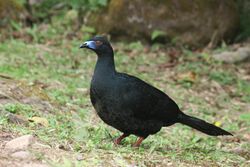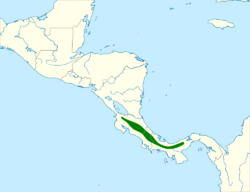Biology:Black guan
| Black guan | |
|---|---|

| |
| Scientific classification | |
| Domain: | Eukaryota |
| Kingdom: | Animalia |
| Phylum: | Chordata |
| Class: | Aves |
| Order: | Galliformes |
| Family: | Cracidae |
| Genus: | Chamaepetes |
| Species: | C. unicolor
|
| Binomial name | |
| Chamaepetes unicolor Salvin, 1867
| |

| |
The black guan (Chamaepetes unicolor) is a species of bird in the chachalaca, guan, and curassow family Cracidae. It is found in Costa Rica and Panama.[1]
Taxonomy and systematics
The black guan shares the genus Chamaepetes with the sickle-winged guan (C. goudotii) of western South America and may form a superspecies with it.[2]
Description
The black guan is 62 to 69 cm (2.03 to 2.26 ft) long and weighs about 1,135 g (2.502 lb). Adults have all black plumage with contrasting bright blue facial skin around a red eye. Their legs and feet are pinkish-red. Juveniles are similar but less glossy and their underparts browner and their facial skin is blackish or dark brown.[3]
Distribution and habitat
The black guan is found from the Cordillera de Guanacaste in northern Costa Rica to western Coclé Province in Panama. It inhabits cloudforest in the Talamancan montane forest ecozone. It prefers steep terrain in the temperate, subtropical, and tropical zones, usually between about 1,000 and 2,250 m (3,280 and 7,380 ft) of elevation, but in some areas as low as 800 m (2,600 ft) and in others as high as 3,000 m (9,800 ft).[3]
Behavior
Movement
The black guan is thought to be mainly sedentary but there is some evidence of seasonal elevation changes.[3]
Feeding
The black guan forages singly, in pairs, or in small groups. Its primary diet is fruits; studies in Costa Rica have identified at least 35 different species eaten. It mostly feeds in trees but will also eat fallen fruit on the ground.[3]
Breeding
The black guan's breeding season is believed to span from February to June. The one described nest was a small platform of twigs and leaves placed in a clump of epiphytes in a tree 4.5 m (15 ft) above the ground. The clutch size is two or three eggs.[3]
Vocal and non-vocal sounds
The black guan's vocalizations include piping calls in the breeding season, a "a low, deep 'ro-rooo' or coughing 'kowr' if disturbed", and a "tsik tsik..." alarm call. At dawn and dusk it gives a "loud, sharp, crackling" wing-rattling display.[3]
Status
The IUCN has assessed the black guan as being of Least Concern.[4] In Costa Rica it is fairly common in protected areas but in Panama only locally "rather numerous". However, even where nominally protected it is heavily hunted for food.[3]
References
- ↑ Gill, F.; Donsker, D.; Rasmussen, P. (July 2021). "IOC World Bird List (v 11.2)". https://www.worldbirdnames.org/.
- ↑ Remsen, J. V., Jr., J. I. Areta, E. Bonaccorso, S. Claramunt, A. Jaramillo, D. F. Lane, J. F. Pacheco, M. B. Robbins, F. G. Stiles, and K. J. Zimmer. Version 24 August 2021. A classification of the bird species of South America. American Ornithological Society. https://www.museum.lsu.edu/~Remsen/SACCBaseline.htm retrieved August 24, 2021
- ↑ 3.0 3.1 3.2 3.3 3.4 3.5 3.6 del Hoyo, J. and G. M. Kirwan (2020). Black Guan (Chamaepetes unicolor), version 1.0. In Birds of the World (J. del Hoyo, A. Elliott, J. Sargatal, D. A. Christie, and E. de Juana, Editors). Cornell Lab of Ornithology, Ithaca, NY, USA. https://doi.org/10.2173/bow.blagua1.01 retrieved September 26, 2021
- ↑ Cite error: Invalid
<ref>tag; no text was provided for refs namedIUCN
Further reading
- Garrigues, Richard; Dean, Robert (2007). The Birds of Costa Rica. Ithaca: Zona Tropical/Comstock/Cornell University Press. p. 10. ISBN 978-0-8014-7373-9.
- Angehr, George R.; Dean, Robert (2010). The Birds of Panama. Ithaca: Zona Tropical/Comstock/Cornell University Press. p. 10. ISBN 978-0-8014-7674-7.
External links
- BirdLife species factsheet for Chamaepetes unicolor
- "Black Guan media". Internet Bird Collection. http://www.hbw.com/ibc/species/black-guan-chamaepetes-unicolor.
- Black Guan photo gallery at VIREO (Drexel University)
Wikidata ☰ Q748732 entry
 |



